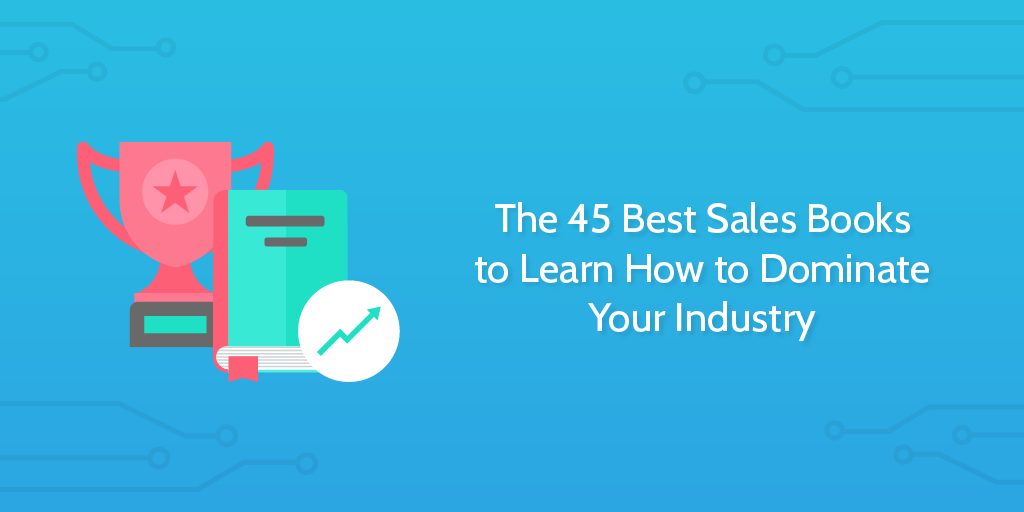 Sales is one of the core aspects of how a business functions.
Sales is one of the core aspects of how a business functions.
Without sales, your brilliant product will just sit there, neglected and unused.
But no one is born as a brilliant salesperson, just as no one is born with an innate knowledge of how to run an effective outbound strategy.
We learn these things on the way. A lot of the time, we learn from the sales jobs we’ve had. But we shouldn’t limit ourselves to that. Why not learn from the best salespeople, the highest performing companies, and the extreme examples?
In this Process Street article, we’re bringing expertise galore to your bookshelf or Kindle. We’ll go through our 7 key recommended reads, and follow that with 38 more sales books to satisfy your niche, industry, or needs.
Our 7 key picks for the best sales books

We have a mix of classics, new releases, and some broader strategy related materials which can help us understand how sales fits in to the broader operations of a company.
I’ve written on everything from how the pyramids were built, to how a franchise works, to the best way to learn Spanish.
But I also write a lot about sales.
I write a lot about sales because I was in sales, selling away and encountering all the challenges and successes we all experience.
Sales can be tough, and it helps to have some guidance along the way. These 7 books should hopefully expand your sales knowledge to feel comfortable looking at your sales techniques, sales processes, and sales organization from every angle.
Secrets of Closing the Sale: For Anyone Who Must Get Others to Say Yes!
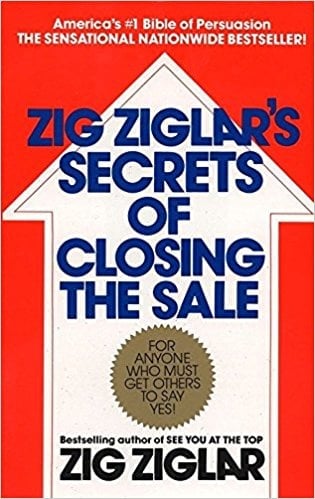 Zig Ziglar is a sales guru who we’ve referenced and quoted countless times in articles over the years.
Zig Ziglar is a sales guru who we’ve referenced and quoted countless times in articles over the years.
His book Secrets of Closing the Sale covers the most difficult area of sales. Closing the sale isn’t a task that can be automated or outsourced in most industries. It requires a salesperson to present the opportunity in a certain way and to know when to act on a moment of promise.
Ziglar has multiple actionable tricks which he recommends throughout the book. These range from philosophical ideas of what a sale is to psychological guidance like tells a client might subtly let slip.
First published in 1985, Ziglar’s work has retained its resonance over the years and his reputation has grown in stature. With all the technological changes which have occurred since then, the human aspect of a sale remains. It is this interpersonal relationship which Ziglar focuses on and where the most value can be gained.
A useful book for salespeople of all varieties and levels of experience, you can pick up a copy here: Secrets of Closing the Sale.
SPIN Selling
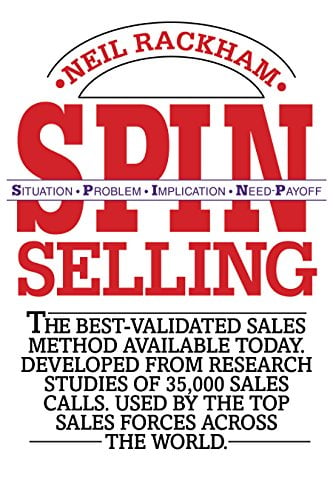 Sticking with the theme of sales classics, SPIN Selling by Neil Rackham remains one of the go-to texts for aspiring salespeople.
Sticking with the theme of sales classics, SPIN Selling by Neil Rackham remains one of the go-to texts for aspiring salespeople.
Rackham and his team analyzed over 35,000 sales calls during the late 80s to try to understand what makes a sale successful. SPIN Selling was arguably one of the first data driven investigations into sales methods and practices, and its wisdom is still appreciated today.
The key insight of the book is that sales is about questions.
Successful sales typically involved the buyer talking more than the seller. This occurred because the seller was asking questions and gaining insight into the buyer’s needs while building a rapport with the client.
Rackham took this and tried to break down the mechanics of how these questions operated. This led to him constructing the framework which exists as the core concept of the book:
- Situation
- Problem
- Implication
- Need-Payoff
Each of these categories both represents a stage in the sale and a type of question to be asked.
Situation questions are looking to gain insight into the buyer’s current scenario. From understanding this environment, the seller then focuses onto the pain points to identify the problem or problems. Dwelling on the problem and probing deeper and deeper prepares the buyer for the Implication questions. These discuss the problem in relation to potential solutions. At this point the seller isn’t explicitly stating the seriousness of the problem nor the effectiveness of their solution; merely letting the buyer work up to these conclusions themselves.
The final section is the Need-Payoff, which is where the salesperson does the final step in tying themselves into the situation. The buyer is asked about their Explicit Needs and are encouraged to describe themselves the solutions they think the product can provide for them.
The SPIN process is about getting the buyer to sell themselves the product and to convince themselves by saying the problems and solutions out loud.
For sales call management, SPIN Selling is an absolute must. You can buy a copy here: SPIN Selling.
Little Red Book of Selling: 12.5 Principles of Sales Greatness
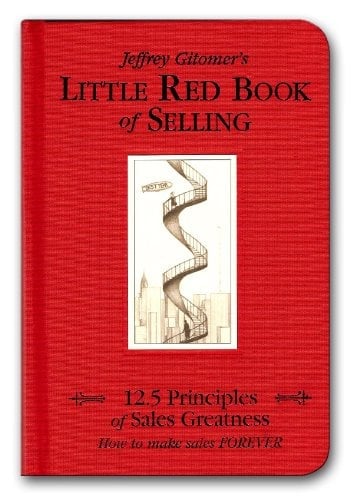 Jeffrey Gitomer has pulled together a practical guidebook for all kinds of sales.
Jeffrey Gitomer has pulled together a practical guidebook for all kinds of sales.
This book builds on his previous work, The Sales Bible, to succinctly – and humorously – provide answers to almost all the questions a salesperson will typically ask.
Gitomer likes to play around in the writing of the book, which can help keep it interesting. Instead of a dense analytical tome, you end up with analogies, metaphors, and creative drawing together of concepts.
A good example of the writing style comes when he explains why it’s a little red book, not a little blue or green book. Red is the color of passion, which you need to be good at sales. Red is the color of love, an emotion you must have for your product otherwise you’re selling the wrong thing. Red is the brightest color (it is actually a shade of green) and to succeed in sales you need to be bright. Etc.
But it isn’t all strange truisms.
The text has countless recommendations for various scenarios. From how to be successful to how to get out of a slump. From resources you can call upon to how to create a personal brand.
The wide ranging scope of this text makes it ideal for someone who is just getting started in sales, or has just realized that this is the career path they want to commit to. You can pick up a copy here: Little Red Book of Selling
Heavy Hitter I.T. Sales Strategy: Competitive Insights from Interviews with 1,000+ Key Information Technology Decision Makers
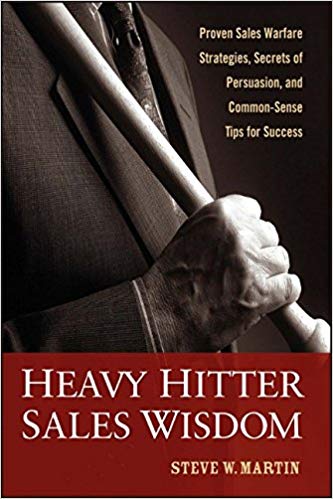 This text from Steve Martin (not that Steve Martin) is one of the newest books in the list.
This text from Steve Martin (not that Steve Martin) is one of the newest books in the list.
Martin teaches sales strategy at the Southern California Marshall School of Business and has undertaken a massive study to better understand the mind and motivations of buyers.
There are 6 key insights I’ll mention to give you a quick feel of the text.
While Martin finds that the largest minority of customers want to have a salesperson who listens to their needs, the surprising finding was that 30% of buyers are looking to be challenged by a salesperson and presented with solutions they didn’t know about, or shown problems they didn’t know they had.
Even if you have to go through a committee of different decision makers, Martin reveals that 90% of the time there is only one real decision maker. Everything rests on the whim of a particular person. It’s probably worth identifying who that is.
Martin found that you don’t have to be the market leader to sell. The study showed that 63% of buyers would be happy to purchase from a “well known” brand with 85% of the market leader’s functionality when the price was 80%. Some great insights into how to break into markets.
Some industries interact with price differently to others. Martin outlines three different types: price conscious, price sensitive, and price immune. Government, for example, is normally price immune: they will select the product they think is best regardless of price. The book breaks down the research industry by industry to help inform your pricing strategies.
In highly bureaucratic organizations, sales, IT, and engineering tend to have the best ability to push through purchases. It’s typically easier for those departments to sign off on a sale than it is for marketing or human resources.
Martin also outlines the kind of salesperson who is preferred in different industries. Media and fashion, for example, much prefer charismatic salespeople even when their knowledge of the product isn’t as good as it could be. Other departments and industries can prefer a studied and analytical salesperson even if they wouldn’t want to spend time with them socially.
So many insights. Heavy Hitter is definitely a text for people selling IT and software above all, but has a great amount of use for any salesperson who wants to better understand current industry landscapes. You can grab a copy here: Heavy Hitter IT Sales Strategy.
Sales Growth: Five Proven Strategies from the World’s Sales Leaders
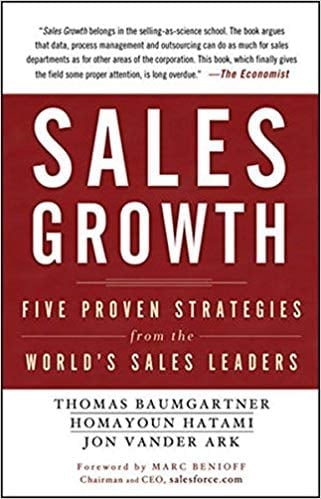 Compiled by McKinsey, this book is authored by Thomas Baumgartner, Homayoun Hatami, and Maria Valdivieso de Uster, with a foreword from Salesforce CEO Marc Benioff.
Compiled by McKinsey, this book is authored by Thomas Baumgartner, Homayoun Hatami, and Maria Valdivieso de Uster, with a foreword from Salesforce CEO Marc Benioff.
As the title suggests, the book focuses on 5 key themes and attempts to pull actionable insights into these. Depending on the section, you might find data backed research, case study backed insights, or more personal stories of experiential learning.
The 5 key themes covered in the book are:
- Finding growth before your competitors do
- Selling the way customers want
- Optimizing sales operations and technology
- Finding sales leaders who continually challenge the status quo and thoughtfully manage performance
- Leading sales growth to make change happen
As you can see from those five, the text covers strategy, the psychology of the sale, best technical practice, management, and leadership.
The body of the book was constructed from interviews with 200 of the world’s top sales leaders in order to condense their knowledge down to a concise go-to guide for aspiring salespeople.
My recommendation with this book is that it suits someone who wants to not only sell well now, but aspires to manage and lead within a sales capacity. The text feels like it provides a thorough scope of sales operations in a way which other texts mentioned so far do not look to do.
The book seems to recognize that the front line of sales is simply the starting point from which whole organizations can be built. Benioff sums this ethos up well in the foreword:
Anyone on the front line has incredible access to information about the customer, the competition, and the changing market. Sales gives us the intelligence necessary to know our customers. deliver the right products, and compete. It’s really the heart of an organization, the vital connection to the customer—and far too often it’s overlooked. (pg.XIV)
You can pick up a copy here: Sales Growth.
Fast Second
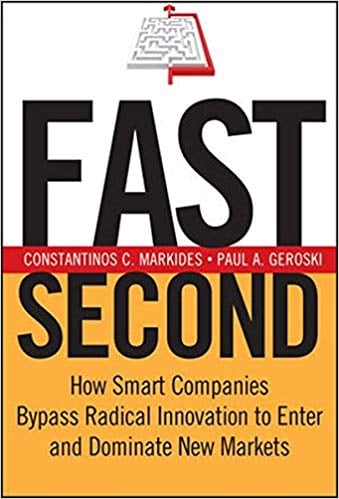 Paul Geroski and Constantinos Markides’ 2005 text, Fast Second: How Smart Companies Bypass Radical Innovation to Enter and Dominate New Markets, is not strictly a sales book but it does cover a good element of overall strategy and how sales can fit into this complex mix.
Paul Geroski and Constantinos Markides’ 2005 text, Fast Second: How Smart Companies Bypass Radical Innovation to Enter and Dominate New Markets, is not strictly a sales book but it does cover a good element of overall strategy and how sales can fit into this complex mix.
The book covers case studies like Microsoft and Amazon to see how they stepped up into the number 1 spot in their market despite established companies already existing. Published in 2005, it’s easy to think of other companies more recently which have a similar story of progression.
Diving into these case studies and really trying to work out what it is that makes a business successful, rather than assuming success is just the other side of innovation, leads Geroski and Markides to go deep into the mechanics of growing in existing markets.
Their ability to smash apart the concept of the first mover advantage led to the book being nominated for the 2005 Financial Times and Goldman Sachs Business Book of the Year Award.
The reason why it is included in this privileged list is because it takes some of the mythology away from business. Having a good idea isn’t enough. Anyone can have a good idea. The winner, as the book proposes, is the one which acts upon the concept at the right time and with the right approach. The mechanics of business, the day to day operations, are hugely important in whether success can be achieved.
In this article for the Harvard Business Review, the authors make clear that their fast second concept can be seen pretty much whenever technological development opens up a new market or niche:
The first commercial computer, UNIVAC, had the market to itself until 1953, when IBM introduced its first business computers. IBM did not aspire to technological dominance but relied instead on its sales force and its close knowledge of, and association with, business users. In late 1954, UNIVAC had an installed base that was eight times larger than IBM’s. Just six years later, this market share ratio had reversed, with IBM emerging as the leader.
This book would be great for someone who wants to understand how sales fits in operationally within a larger organization, and how it can be leveraged strategically for best results.
You can grab yourself a copy here: Fast Second.
Good Strategy, Bad Strategy
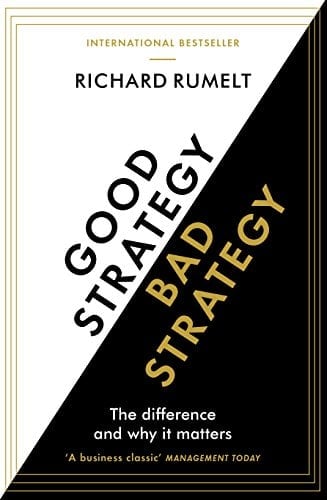 This 2011 book from Richard P. Rumelt rounds off our list of key recommendations with another dive into the world of strategy.
This 2011 book from Richard P. Rumelt rounds off our list of key recommendations with another dive into the world of strategy.
Rumelt had been described by McKinsey Quarterly as:
a giant in the field of strategy
and somewhat more concisely:
strategy’s strategist.
Now, you may think this is just posturing and typical of the over-egged praise we like to heap on people for actually achieving little, but in 1972 Rumelt was the first person to uncover a statistical link between corporate strategy and profitability. Based at the UCLA’s Anderson School of Management, he consults both public and private sector including the US Department of Defense and companies like Shell. Rumelt has been in on the strategy game for a long time and this book is described by the Financial Times as:
his long-awaited tour de force.
The book is written in a fairly accessible manner so that anyone can jump in and take away the lessons. Yet, it doesn’t feel as though the content is being dumbed down for a casual reader.
In part, this is likely because of the emphasis and approach which Rumelt has chosen to take. Real world examples are drawn on, but they’re less case studies and more illustrations. The important information isn’t of a form which could be summed up in an equation with CAC, LTV, and some Greek symbol. This discussion instead is often more abstract.
It reads, at times, like a philosophy book. There is a clear effort made to clarify concepts and put forward a polished analytical set of ideas and tools for the text to utilize. This surgical approach then can be put aside as examples are presented and playfully picked apart.
The end result is a clear clarification on what strategy is, what it isn’t, how you can conceptualize strategy, and how you can attempt to implement it.
Rumelt gives a range of actionable prescriptions throughout the book, including the 3 step process to recognizing and executing strategy:
- Diagnose the challenge. Simplify the challenge by understanding its components. Then prioritize those sub-challenges.
- Develop a guiding policy. This is your overall approach to how you’ll deal with the challenge at hand. Kind of like choosing your methodology.
- Create a set of coherent actions. Create your plan, procedures, or processes – or all of them. Make sure they interlink and work together.
There are a whole load of in depth strategy discussions throughout the book and the outcome for a reader seems to be to develop the tools to reapply this strategy knowledge in any setting, business or elsewhere.
This is your high level text in the 7 key recommendations. There isn’t much direct discussion of sales explicitly, but the idea of how to construct a strategy accommodating the resources you have with the aim of achieving specific goals, is vital for anyone who wants to take up a leadership position.
This text will help point you in the right direction. You can find a copy here: Good Strategy, Bad Strategy
More sales books which could change your operations

I hope those 7 above can collectively cover most of the knowledge you’re hoping to add to your sales expertise.
But they are only 7.
It’s impossible to cover all niches in just that short number of books. That’s why I’ve added on this list of top reads which may be more suited for you.
There’s a great deal of self-improvement, strategy, industry-specific, and technical breakdowns of key moments of a sale.
Have a read through to see what might be best to add to your growing reading list!
The Greatest Salesman in the World
Og Mandino’s 1968 text starts off this list with with something a little different. This book of fiction tells the story of a young boy called Hafid in a rags to riches tale.
The book explores themes of motivation, success, and is regarded as a guide to the philosophy of salesmanship. If you want something a bit more enjoyable to read before bed, check this one out.
Purchase here: The Greatest Salesman in the World
The New Strategic Selling
Robert Miller and Stephen Heiman’s The New Strategic Selling bears similarities with Rackham’s SPIN Selling. The two books were published around the same time in the 80s and both present the idea of systemized sales.
This exploration provides the inside scoop on the advice and consultancy Miller and Heiman would give to huge businesses on how to better their sales approaches. A really solid overview of the tried and tested approaches of the industry.
Purchase here: The New Strategic Selling
Mastering the Complex Sale
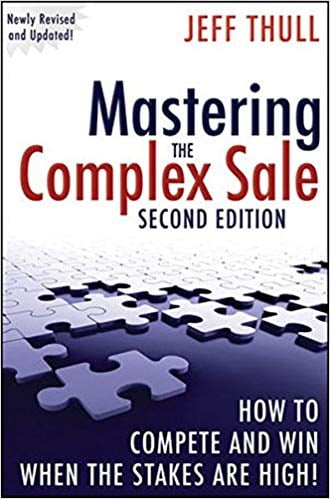 Jeff Thull‘s book provides one of the more niche examples in the list and is perfect for someone who is looking to sell to large bureaucratic organizations or governmental bodies.
Jeff Thull‘s book provides one of the more niche examples in the list and is perfect for someone who is looking to sell to large bureaucratic organizations or governmental bodies.
Mastering the Complex Sale aims to pick apart the process of dealing with multi-layered approval processes and the difficulties of dealing with multiple stakeholders. If this sounds like your day to day, then it could be worth a read!
Purchase here: Mastering the Complex Sale
Selling to Big Companies
Jill Konrath takes a similar approach to Thull, publishing Selling to Big Companies in 2005, 2 years after Mastering the Complex Sale.
The book presents a hands-on how-to of approaching large organizations. From finding your entry point to crafting your messaging, the text is a practical guide to closing those big sales.
Purchase here: Selling to Big Companies
The Psychology of Selling
Many of you will already be familiar with Brian Tracy, whether from this book or another. His writings on success and achievement through the 80s and 90s were hugely popular.
The core premise of the book is that sales is super important in businesses and more broadly in society, and that fractional gains by individual salespeople can add up to great outcomes. However, you have to have a positive self-concept and a mindset of undertaking challenges and overcoming them. The book guides you through implementing this in your own behaviors.
Purchase here: The Psychology of Selling
Perfect Selling
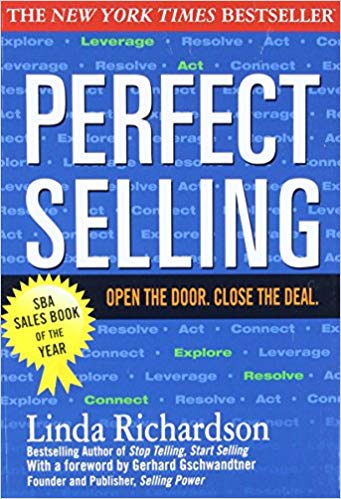 Linda Richardson‘s 2008 book is a go to guide for carving out every competitive edge you can muster in your sales process. She describes it as a book about winning not about selling.
Linda Richardson‘s 2008 book is a go to guide for carving out every competitive edge you can muster in your sales process. She describes it as a book about winning not about selling.
This New York Times bestseller is a really practical and hands-on investigation of how you – as a salesperson – can improve your approach and smash your targets. Ideal for someone new to sales who really wants to master best practices.
Purchase here: Perfect Selling
How to Master the Art of Selling
Tom Hopkins‘ 1980 classic How to Master the Art of Selling is built on his experiences as a failing salesperson who managed to turn it all round to make $1 million after 3 years – around about $3 million in 2018 purchasing power.
Hopkin’s uses his concept of a Champion to refer to top sales people and the book aims to give you the tools you need to become a Champion too. The book also covers some really useful ground about the relationship between marketing and sales, and how a salesperson can help build that relationship and leverage it.
Purchase here: How to Master the Art of Selling
To Sell is Human
Daniel Pink‘s text turns the classic sales philosophies and truisms upside down. Pink draws on social science research to create a well crafted and, at times, counter-intuitive lesson on the role sales has inside and outside the office.
Part of the premise is that 1 in 9 people in the US work in sales. So sales is important. But Pink presents the idea that all of us work in sales, as the fundamental elements of sales occur and appear in all jobs. Pink explores this idea and looks at how to sell without only focusing on cold-calling or corporate meetings.
Purchase here: To Sell is Human
Influence: The Psychology of Persuasion
Dr. Robert Cialdini, Professor of Psychology at Arizona State University, wrote this 1984 book to explore the key ways people can be influenced by what he calls Compliance Professionals. The psychology of persuasion and the science of persuasion have become key areas of study and business practice in the years following Cialdini’s seminal text.
You can find a really good video summary of the book in this video below:
Purchase here: Influence
Cracking the Sales Management Code
Jason Jordan and Michelle Vazzana‘s 2011 book differs from the kind of 80s classics we’ve seen so far in this list. While the 80s was a time of self-improvement and sales techniques, more recent years have seen a greater emphasis on data and organization. This move away from an individualist look at sales to a more holistic and empirical perspective is a trend which has arisen from the increased incorporation of technology in the way modern sales operates.
This text focuses on how to zone in on the key metrics to determine success and optimization.
Sales may be an art, but sales management is a science.
Purchase here: Cracking the Sales Management Code
Coaching Salespeople Into Sales Champions
Keith Rosen focuses in this book on the role of a sales manager in the ongoing learning process. Sales training, the book posits, is a vitally important part of building successful sales teams. However, sales training is simply the first step in growing your team.
The book looks at concepts like leadership and mentoring in an attempt to help the reader to foster an environment conducive for their team to succeed. This one is a definite go-to text for people who want to move into sales management or executive positions.
Purchase here: Coaching Salespeople Into Sales Champions
From Impossible to Inevitable
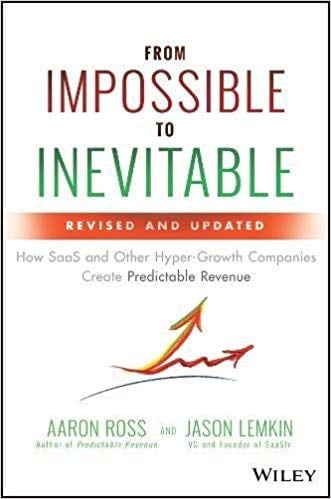 Aaron Ross and Jason Lemkin explore what they refer to as hyper-growth companies, and chart their path to sustainable and predictable revenue.
Aaron Ross and Jason Lemkin explore what they refer to as hyper-growth companies, and chart their path to sustainable and predictable revenue.
This book presents a more strategic outline of company growth and looks at trends in operations. The third section of the book is specifically about scaling your sales team and should be read by any company looking to boost that area.
The core idea of the book is the importance of systemizing your operations and optimizing repeatable processes – a book for any keen Process Street user.
They present 3 painful truths for business, and explain why you need to think differently:
- Myth 1: “Build it and they will come” is a fairy tale
- Myth 2: Growth exposes your weaknesses
- Myth 3: It’s hard to build a big business out of small deals
Purchase here: From Impossible to Inevitable
Tools of Titans: The Tactics, Routines, and Habits of Billionaires, Icons, and World-Class Performers
Tim Ferriss has had many outings on the Process Street blog. Much of our content on productivity has drawn from his work. Tools of Titans was a number 1 New York Times best seller and builds on his previous successes like the 4 Hour Workweek.
The premise of this book is that there are trends in the way super successful people live their day to day lives. Ferriss searches for these trends through around 200 interviews with high performing individuals and passes on his key findings to you. A must read book for personal productivity.
Purchase here: Tools of Titans
Never Eat Alone
Keith Ferrazzi investigates the world of networking in this 2005 exploration of getting to the top.
While many other texts in this list look at themes of self-improvement, Ferrazzi eyes other people as key to your path to success. The adage “it’s not what you know, but who you know” always has a grain of truth to it. Ferrazzi plays on that by exploring the day to day behaviors of what makes a good networker, and the necessary strategies to pull it off.
Purchase here: Never Eat Alone
Start with Why: How Great Leaders Inspire Everyone to Take Action
Simon Sinek has gone viral a number of times over the past few years. His work on leadership has been in the public eye for longer, and this 2009 text focuses on attempting to cultivate a leadership style best suited to managing a modern workforce.
The core concept in the book is inspiration. Sinek boils down into the motivations of people in order to craft leadership behavior which can grab onto those motivations in order to push someone to achieve. Inspiration, for Sinek, isn’t just something which happens but is something which can and should be cultivated.
Purchase here: Start with Why
Sell or Be Sold: How to Get Your Way in Business and in Life
Grant Cardone sums up the dog eat dog mindset in his text Sell or Be Sold: How to Get Your Way in Business and in Life. For Cardone, everything should be treated as a sale.
This book focuses in on the fundamentals of selling and how to make a sale, and then offers the reader the chance to use that knowledge to drive success in all areas or spheres of life. You can check out a lecture from Cardone below:
Purchase here: Sell or Be Sold
How to Win Friends and Influence People
Dale Carnegie’s 1936 book has been a seminal text for almost a century and one of the true foundational texts of the self-improvement and self-help genre.
The guide that this 30 million selling copy gives you contains advice that is still as true today as it was the day it was written. The book aims to help you build a successful and fulfilling environment for yourself, and one which benefits the lives of the others around you. As well as being a book for self-improvement, a classic like this serves as a go-to dinner party book.
Purchase here: How to Win Friends and Influence People
Deep Work: Rules for Focused Success in a Distracted World
Cal Newport delves into the difficulties of working and operating in the modern world.
Facebook, Twitter, Reddit, Tumblr, Quora, all vying for your attention. Ads and suggested articles on every page you visit. Notifications and messages popping up every few minutes.
We live in a distraction filled world.
And it’s hard to fight through the fog to get done what you want to get done.
This book aims to help you find your way through these distractions and give you a way to stay focused and achieve your goals. Published in 2016, it draws upon psychological understandings to help you push forward.
Purchase here: Deep Work
The Subtle Art of Not Giving a F*ck: A Counterintuitive Approach to Living a Good Life
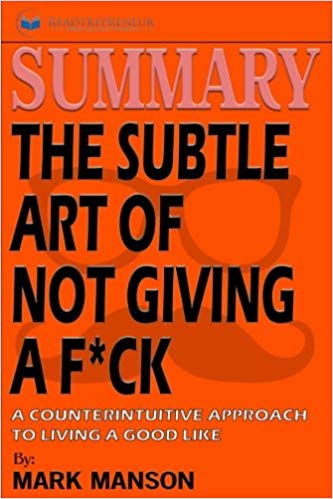 Mark Manson cuts through the bullshit with this upfront and provocative text.
Mark Manson cuts through the bullshit with this upfront and provocative text.
Much like Newport’s book about avoiding distractions, Manson recognizes that there are other emotional distractions which eat up our brain power every day. Most of these emotional worries are trivial and minor – they just don’t matter.
Newport presents ways to focus on what does matter and to switch off from the other stresses and strains which bear down on us.
Purchase here: The Subtle Art of Not Giving a F*ck
The Sales Acceleration Formula
Mark Roberge provides in this book what I would describe as a formula for SaaS sales success. The lessons and approach are applicable to all industries, but so much of it mirrors the best practices in SaaS sales, that I want to put that emphasis out there.
The book looks at putting together a sales team and growing it; scaling it carefully in a data-backed manner. The book incorporates a lot of advice and recommendations for how you can leverage inbound sales within your business.
A must read for inbound sales teams and managers.
Purchase here: The Sales Acceleration Formula
Hooked: How to Build Habit-Forming Products
Nir Eyal presents us with an in-depth exploration of the psychology of why we like and use certain products so much more than others.
We haven’t touched on product design much in this list as it doesn’t fit tightly into the normal ideas of sales. However, for those of us who work in software, we all know how much time and effort goes into making a piece of software usable and good to use.
As sales people, you’re on the front line of understanding customer needs. Your understanding of clients is vital not just to make the sale, but also to help develop the product so that it better meets those needs. This kind of holistic approach is used constantly and a truly modern salesperson should prepare themselves for being able to fulfill this role.
Purchase here: Hooked
Everybody Lies
Seth Stephens-Davidowitz‘s 2017 text is one of the most recent books in this list. You can tell because the core premise is centered around what big data can tell us about who we really are. You didn’t hear Zig Ziglar telling you about that!
Steven Pinker’s review of the book was very positive, and receiving high praise from top academics should tell you something about the level of scrutiny and rigor which has gone into the text. Pinker said:
This book is about a whole new way of studying the mind … endlessly fascinating
Stephens-Davidowitz analyzed data from Google to create an understanding of our great collective unconscious – to take a Jungian perspective. This insight into what people really want and think is a great way to build your understanding of the psychology of how to sell.
Purchase here: Everybody Lies
Pitch Anything: An Innovative Method for Presenting, Persuading, and Winning the Deal
Oren Klaff is a bit of a hero when it comes to raising money. He has used his method to raise over $2 billion, and is now spelling it out in deep detail for you.
This 2011 text looks at how to craft a pitch, what to focus on, and what kind of story you should be telling. The insights in the book can be adapted and repurposed for use in so many different environments.
According to Klaff, pitching isn’t an art – it’s a science.
Purchase here: Pitch Anything
The Ultimate Sales Machine
Chet Holmes presents us in this book with 12 key strategies to use – in an off the shelf way – in any business in order to boost your sales.
Holmes breaks down the strategies so that they’re easy to understand and implement, while also instructing you as to what scenarios they’re best for.
At the end of the book you should be able to identify which strategies you want to implement into your business and how you’re going to do it. A thorough and actionable read.
Purchase here: The Ultimate Sales Machine
Extreme Ownership: How U.S. Navy SEALs Lead and Win
Jocko Willink and Leif Babin bring military expertise and precision into the workplace.
This 2015 text explores the personal journeys, success, and learnings which have come from time spent in the US Navy SEALs and pulls out the elements which can be applicable for you in your professional and personal life.
There’s a heavy biographical feel to the text and the stories of their pursuits can be gripping. Watch the video from Business Insider below to get a feel:
Purchase here: Extreme Ownership
Mindset: The New Psychology of Success
Carol Dweck, in this 2006 text, delves into psychology to find out what is holding us back and what’s driving us forward.
One of Dweck’s key ideas in the book is the concept of the growth mindset, saying:
Becoming is better than being.
The growth mindset is really a realization that you are capable of much more than you can do right now. It’s the knowledge that skills and abilities are learned and taught. We all already know this, but we’re often wary of applying it to ourselves and our own potential.
Dweck helps to unlock this potential by showing you that your mindset for improvement is holding you back, and presenting you with the steps to change that.
Purchase here: Mindset
Emotional Intelligence 2.0
Dr. Travis Bradberry‘s book was a game changer when it first came out. The recognition of the importance of EQ has been growing year on year, with people identifying greater and greater correlations between EQ and material success.
Bradberry takes an analytical, and academic without being impenetrable, approach to what emotional intelligence is and how we can harness and grow our own emotional intelligence.
The book presents a science backed approach to self-improvement.
Purchase here: Emotional Intelligence 2.0
The 7 Habits of Highly Effective People
In this 1989 book by Stephen R. Covey, we explore how successful people operate and spend their time.
From here, Covey pulls out the key habits which just keep cropping up again and again. The cliffnotes version is:
- Be Proactive
- Begin with the End in Mind
- Put First Things First
- Think Win-Win
- Seek First to Understand, Then to Be Understood
- Synergize
- Sharpen the Saw
But I recommend dipping into the book to pull out the full understanding.
Purchase here: The 7 Habits of Highly Effective People
Rejection Proof
Jia Jiang‘s story of a personal journey of rejection is gripping and at times hilarious. Jiang describes 100 days of rejection and how this experience of being constantly knocked back had taken away his fear.
What more can you achieve in life when you take away your fundamental fear of rejection? Jiang discusses how this made him a better and more effective person. Check out this Talks at Google video to hear his story:
Purchase here: Rejection Proof
The Challenger Sale: Taking Control of the Customer Conversation
Matthew Dixon and Brent Adamson bring this list back to its core concept with their book, The Challenger Sale.
This book looks at the interaction you have as a salesperson with your client and how to steer that conversation in the way you want it to go.
InsightSquared actually requires all of its SDRs to read the book as part of their onboarding process. In the blog which describes what InsightSquared learned from the book, they cite the number 1 takeaway as being:
The buying experience should be your top priority
Not lower prices than your competition, but the attention you have for the customer and the journey you craft. The Challenger Sale would be a really good read particularly for someone doing high-touch sales.
Purchase here: The Challenger Sale
Fanatical Prospecting: The Ultimate Guide to Opening Sales Conversations and Filling the Pipeline by Leveraging Social Selling, Telephone, Email, Text, and Cold Calling
Jeb Blount provides us with the longest title of all the books in the list.
In this text he focuses on the first stage of the sales pipeline: prospecting.
Who are your salespeople selling to if there’s no one in your list? Blount works through the classic prospecting strategies and lays out easy to follow and actionable ways to approach each. Blount’s method will stuff your pipeline full of potential clients to qualify, leading to you bringing the most qualified to the table with your sales team to close more deals.
Purchase here: Fanatical Prospecting
Winning with Data
Tomasz Tunguz‘s text is a pretty complete guide to leveraging data in your company. Published in 2016, it addresses the concerns of the modern company; so much data is coming in, but how do we make the most of it?
The full title of the book is Winning with Data: Transform Your Culture, Empower Your People, and Shape the Future. I think this subtitle gives the clue that data isn’t something which should be just used by one team. Instead data should be leveraged across the company by upskilled employees to maximize its effectiveness.
And that is the key point of the book. Using data well isn’t just about hiring a person to analyze it, but about building a whole company which analyzes it. The culture shift necessary to bring this data focus is one of the core actionable elements of Tunguz’s text.
Purchase here: Winning with Data
Blueprints For A SaaS Sales Organization
Jacco van der Kooij and Fernando Pizarro’s 2017 text zooms in on the SaaS space to give a detailed and in-depth breakdown of how to build an effective and functioning SaaS organization.
SaaS sales has many similarities with every other kind of sales, yet also has its own quirks and subtleties. This book explores those elements and investigates what constitutes best practice in a fairly new market space.
A good option for anyone working in SaaS sales.
Purchase here: Blueprints For A SaaS Sales Organization
Never Split the Difference
Chris Voss comes into this list to tackle an area which maybe we’ve neglected thus far: negotiation.
Voss’s career begins policing the streets of Kansas City and results in him being the FBI’s lead international kidnapping negotiator. He now teaches negotiating at universities and tells us his secrets via his published work.
Never Split the Difference would be particularly useful for someone negotiating big deals. Check out his talk below:
Purchase here: Never Split the Difference
Selling Microsoft: Sales Secrets from Inside the World’s Most Successful Company
Doug Dayton’s 1997 book was one of the bibles of tech sales for a good while. Microsoft had dominated the industry and everyone wanted to learn from their techniques.
Dayton was the Account Manager for Original Equipment Manufacturers (OEMs) for Microsoft and during that time he was responsible for closing a massive 40% of the OEMs business sales.
His approach was called Client-Centered sales and became implemented across the company. In this book he gives you the inside scoop on how Microsoft took over the world.
Purchase here: Selling Microsoft
The Sales Enablement Playbook
Cory Bray and Hilmon Sorey bring us a really good insight into sales organization in their 2017 book The Sales Enablement Playbook.
They break down what sales enablement actually is, and why and how all departments should and can contribute to sales enablement.
A lot of key concepts are discussed, including customer conversation, buyer personas, customer stories, and they outline their definitions of the 3 types of customer conversations. A book that seeks to show you how to have a sales-centric organization.
Purchase here: The Sales Enablement Playbook
The Sales Development Playbook: Build Repeatable Pipeline and Accelerate Growth with Inside Sales
Trish Bertuzzi brings us a breakdown of the 6 key factors required to build a high performing sales team.
The book looks at outbound sales from a perspective of creating sustainable, predictable, and measurable results. With these systems and processes in place, you can leverage them to accelerate growth and drive your business forwards.
The six key sections cover:
- Strategy
- Specialization
- Recruiting
- Retention
- Execution
- Leadership
Purchase here: The Sales Development Playbook
Hacking Sales: The Playbook for Building a High-Velocity Sales Machine
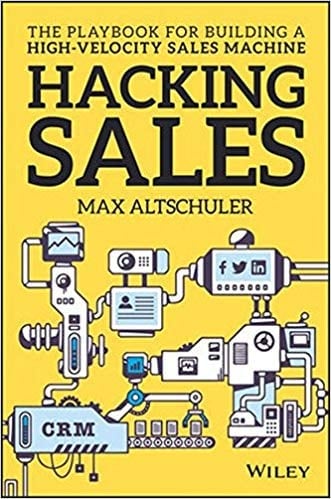 Max Altschuler‘s 2015 text will close off this list. In the book he looks at sales from the perspective of building a sales team from the ground up, in a startup focused kind of way.
Max Altschuler‘s 2015 text will close off this list. In the book he looks at sales from the perspective of building a sales team from the ground up, in a startup focused kind of way.
The book goes on to look at how an effective sales team should function in any business, but the hacking concept behind it is reflected in the way it seeks to make the most of what you have. Sometimes you have to employ techniques which don’t scale, because that’s where you’re at in that moment.
Hacking Sales helps you build streamlined sales processes for your business which best leverage the resources and tools at your disposal.
Purchase here: Hacking Sales
The best sales books: Which is your favorite?
That’s our list.
I’ve pulled out the 7 key texts which I think collectively cover valuable key areas, but all the other books in this list bring something unique to the party.
It would be impossible to recommend just one, but there are enough books here to keep you reading solid for a good while yet.
Did I miss anything? Did I leave out a top text?
Let me know your thoughts on the books I included, and ones I didn’t, in the comments below!







 Workflows
Workflows Projects
Projects Data Sets
Data Sets Forms
Forms Pages
Pages Automations
Automations Analytics
Analytics Apps
Apps Integrations
Integrations
 Property management
Property management
 Human resources
Human resources
 Customer management
Customer management
 Information technology
Information technology



Adam Henshall
I manage the content for Process Street and dabble in other projects inc language exchange app Idyoma on the side. Living in Sevilla in the south of Spain, my current hobby is learning Spanish! @adam_h_h on Twitter. Subscribe to my email newsletter here on Substack: Trust The Process. Or come join the conversation on Reddit at r/ProcessManagement.